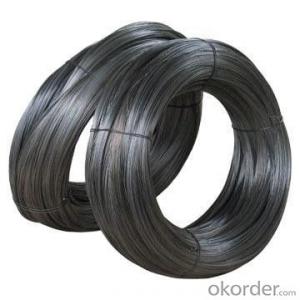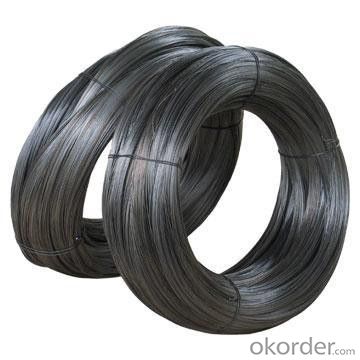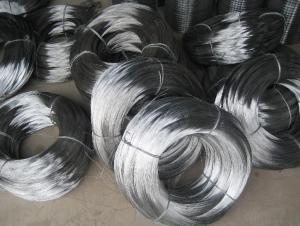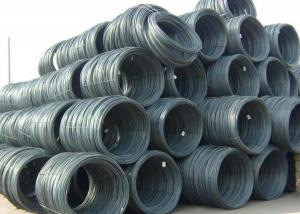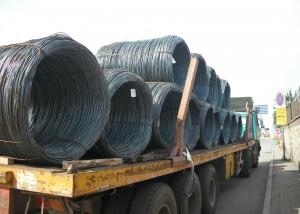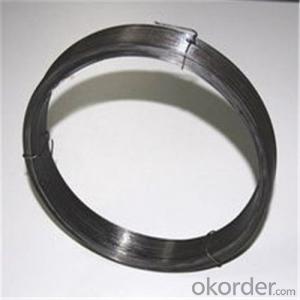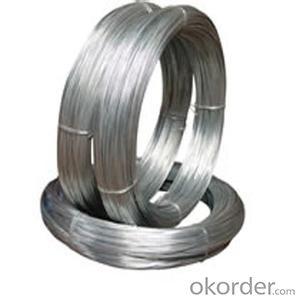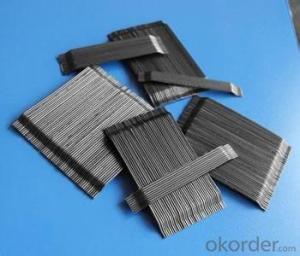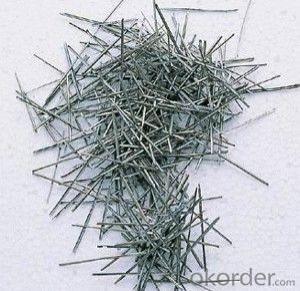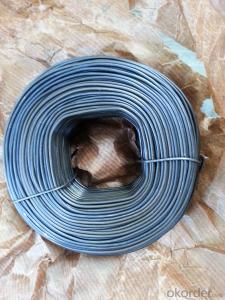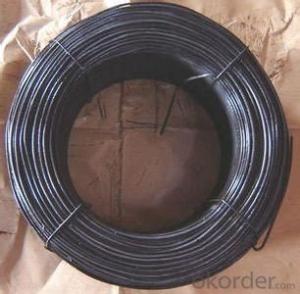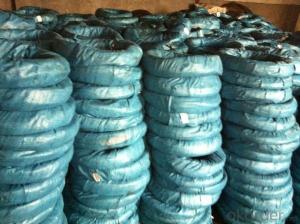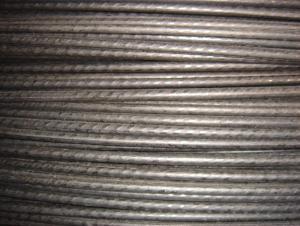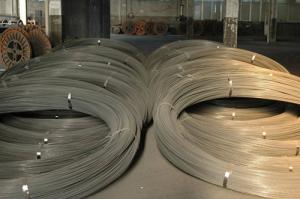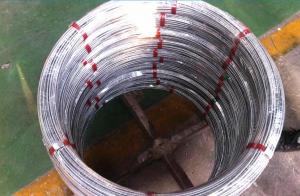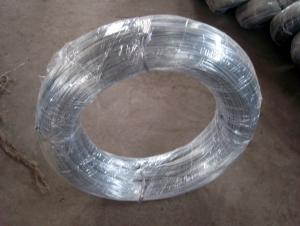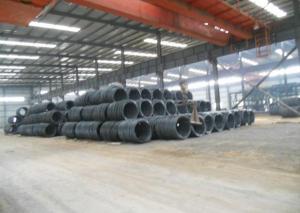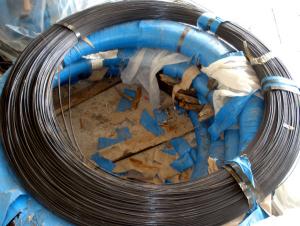Black Annealed Wire
- Loading Port:
- China Main Port
- Payment Terms:
- TT OR LC
- Min Order Qty:
- -
- Supply Capability:
- -
OKorder Service Pledge
OKorder Financial Service
You Might Also Like
Packaging & Delivery
| Packaging Detail: | 1.plastic inside and hessian bag outside2.plastic inside and weave bag outside3.according to customer's request |
| Delivery Detail: | 10-20 days after receive your deposit |
Specifications
1.Black Annealed Wire
2.Black Annealed Iron Wire
3.Black Annealed Binding Wire
Black Annealed Binding Wire Black Annealed Iron Wire Black Annealed Wire
1.Black Annealed Wire
2.Black Annealed Iron Wire
3.Black Annealed Binding Wire
Material: low carbon steel wire
Process: wire drawing---acid washing---rust removing---annealing---coiling
Black Annealed Wire/Soft Annealed Wire | |
Wire Gauge | 0.5mm-6.0mm |
Tensile Strength | 30kg/70kg/mm² |
Elongation Rate | 10%-25% |
Weight | 0.1kg-800kg/Coil |
Packing | Plastic inside and hessian woven outside |
Plastic inside and nylon woven outside | |
- Q: I have a 1989 Nissan 240sx. Somehow the fan caught a hold of the wiring harness and tore all the wires. any idea how much it's going to cost?
- Buying a wiring harness will be prohibitive, and even transplanting one from a wrecking yard can be expensive. The harness can be repaired by splicing in pieces of wire where wire is missing and splicing together damaged pieces of wire. It is tedious but not particularly time consuming - I spliced in a section of harness after an engine fire in about 2 hours, working slowly.
- Q: Obviously speaker wire is what connects the speaker to the receiver; what's the difference between 'zip' speaker wire and...others...?
- Zip cord is just a euphemism for the A/c cord you would wire a light with.
- Q: i am looking for a wire diagram for a 03 eclipse gts with an infinity factory radio and built in amp. i was curios if you can add another amp and sub to this system to give it a little more bass
- 2003 okorder /
- Q: I am trying to replace a GFCI outlet, there are 6 wires -3 White, 2 Black Ground. I have tried to wire it several times and indicator light comes on but it doesn't trip or work when something is plugged in. It's in a box with 2 light switches and I believe feeds down to another switch plug because they are currently not working. As well as my microwave which is on the same circuit. So long story short how do I wire this thing?
- You need to find which set of wires is the feed 1st. Turn off breaker for that circuit disconnect wires . Then turn breaker back on . Which black wire is hot ? Remember which black wire has power. Then shut off breaker again . The black wire that is hot gets connected to your line voltage connection side ( Gold screw on outlet ) the white wire goes to the other line voltage side ( Silver screw ) . The other black and white wire gets connected to the load side of the GFI . If the screws are all the same color for some reason . Remember the longer slot is always the neutral or white wire . The smaller slot is the black or hot wire . Ground to the green screw .Turn breaker back on and test .
- Q: In constructing a large mobile, an artist hangs an aluminium sphere of mass 6kg from a vertical steel wire 0.50m long. On the bottom of the sphere he attaches a similar steel wire, from which hae hangs a brass cube of mass 10kg. How would i calculate the tension in each wire?
- The length of the wire is inconsequential unless you're calculating stretch. The tensile force in the upper wire is simply: Fu = 6 + 10 = 16 kg The tensile force in the lower wire is simply: Fl = 10 kg If you want tensile stress, then you need the wire's cross-sectional area.
- Q: plz answer correctly as soon as possible......why we use stranded 500kV wire?
- After AWG 12 or 14, all cable is stranded. The only purpose of stranded wire is to give it flexibility, regardless of voltage or current. .
- Q: where also is fourth wire hooked in?
- If it is coming from the box at the street into your circuit breaker panel, I'll take a guess. Earth ground (Usually connected to a copper water pipe or a metal pole driven deep into the ground) Neutral (0V) +120 V (Most household circuits) +220 V (Dryers, stoves, possibly air conditioners and other devices needing lots of power. These have special plugs.) Unless you are ABSOLUTELY sure you know what you are doing (and it sounds from your question like you may not be) DO NOT mess around with mains wiring in your house and especially wiring coming into your house, since that isn't even on a surge protector to keep you even remotely safe. If you mess around with this stuff without knowing what you are doing, you could wind up DEAD or in the hospital VERY easily. I can't stress enough how dangerous electricity in large quantities is.
- Q: Two current-carrying wires are lying right on top of each (at a right angle) other, with currents flowing in the wires in the directions pointing up for the vertical wire and to the right for the horizontal wire. The horizontal wire is fixed and does not move. What happens to the vertical wire?Choices:It moves out of the pageIt rotates clockwiseIt rotates counter-clockwiseIt moves to the leftIt moves to the rightIt moves into the page
- The vertical wire rotates (clockwise ?) Draw the situation where you are looking directly at the 'end' or the horizontal wire with the current coming towards you .. the magnetic field from this current is a set of concentric circles with counter- clockwise direction (using the screw-cap rule.. turn counter-clockwise to move cap towards you as it loosens). Now place the vertical wire in this field (close to horizontal wire) and apply Fleming's left-hand motor rule to find the direction of force/motion for the upward current. Above the horiz wire .. Field (first finger) points left, Current upwards (second finger), Motion/force (thumb) direction is towards you. Below the horiz wire .. Field right, Current upwards, Motion/force (thumb) direction is away from you. Seen from the side this gives the vertical wire a rotation in the vertical plane .. which way depends on which side you view it from. ('conventional' viewing would give a clockwise rotation)
- Q: do i need a wiring harness or can i use wire crimps and do it w.o on a 2000 blazer 4wd if u think i need it plz tell me thanks
- unless you known what each wire does get the wiring harness or you very well may destroy your head unit
- Q: Hello my question are:Examples given for wired and wireless communications systems?Compare and contrasted how wired and wireless communications systems function? Assessed the risks associated with wired and wireless communcations systems?(if you can put in simple details that would be helpful, because I understand parts of it but not all)Thank you
- This is more of an engineering question than a physics question... Wired communications offer direct communication links over cables. Each channel has a high bandwidth, and because there are relatively few limitations on the number of cables you can place in parallel, A practically infinite number of channels is possible under the right conditions. Wireless communications work by producing electromagnetic waves encoding signals that can be picked up at the receiving end. The number of available frequencies in the EM spectrum is quite limited, and due to the presence of comparatively large amounts of noise in the environment, there are huge tradeoffs between signal bandwidth, signal power, and the number of available channels. Cellular communications exploit short range communications and wired networks to provide more channels at the expense of requiring more towers with tighter spacing. Overall, wireless communications are much noisier (they experience a lot of signal loss), and they require much more power than their wired counterparts. They are also much more vulnerable to security issues.
Send your message to us
Black Annealed Wire
- Loading Port:
- China Main Port
- Payment Terms:
- TT OR LC
- Min Order Qty:
- -
- Supply Capability:
- -
OKorder Service Pledge
OKorder Financial Service
Similar products
Hot products
Hot Searches
